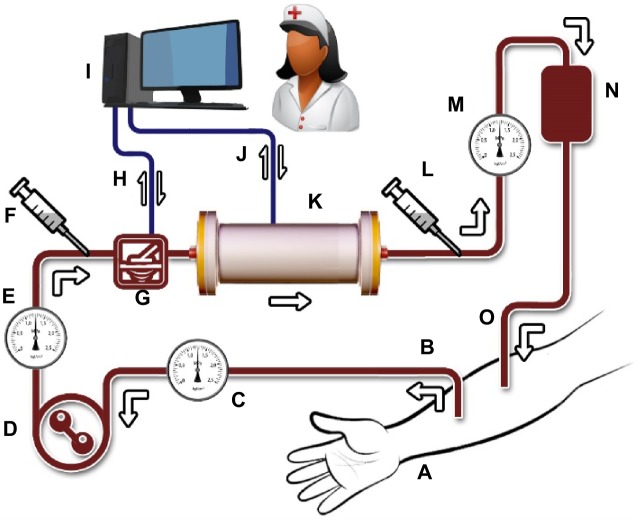Figure 1.
Microarray-oriented homeostasis provider for selective hemoadsorption of uremic waste and toxins from the blood to improve homeostasis in patients with chronic kidney disease. The device is intended to monitor and adjust the titers of target molecules to near optimum homeostasis. MOHP, with the help of a blood pump, circulates blood aseptically in an extracorporeal closed circuit. The main constituents of the proposed device and treatment would include (A) the patient’s hand, (B) blood removed from the artery, (C) an arterial pressure monitor, (D) a blood pump, (E) a heparin pump to prevent blood clotting, (F) a sample of untreated blood, (G) QMD, (H) electronic communication between QMD and COMP, and (I) COMP, including computer hardware, related software, and a trained technician. (J) Electronic communication between COMP and HOMC. (K) HOMC would act as an adsorber cartridge to retain uremic wastes and toxins at levels determined by COMP or as programmed for. As a programmable microarray assembly, HOMC would have adsorptive properties aiming at removing specific ions, molecules, and toxic substances from the patient’s blood. Its molecular adherence makes HOMC to target molecules programmed for by COMP. (L) Sampling of treated blood, (M) venous pressure monitor, (N) air detector and air trap, and (O) processed blood returning to the vein. The tubing, QMD, and HOMC are intended for single use and would be appropriately disposed of after each treatment session.
Abbreviations: MOHP, microarray-oriented homeostasis provider; HOMC, homeostasis-oriented microarray column; QMD, quantitative microarray detector; COMP, computer hardware, related software, and a trained technician.

